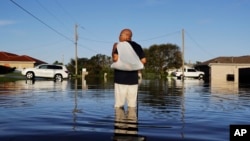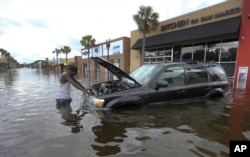Some Florida residents started returning to their homes Tuesday in the aftermath of the widespread destruction spawned by Hurricane Irma, but officials warned the recovery would be frustrating and lengthy.
"The devastation left by Hurricane Irma was far greater, at least in certain locations, than anyone thought," President Donald Trump said in a Twitter comment, adding that "amazing people" were working hard to ease the havoc.
He is planning to visit Florida on Thursday, the White House said.
Teams of emergency workers rescued more people from flooded communities, repaired roads, cleared debris and started restoring power to millions of residences and businesses.
The head of the Federal Emergency Management Agency, Brock Long, said it would take a long time for the state to recover, particularly in the Florida Keys. The archipelago of hundreds of islands, curving south from the southern tip of the mainland, is still partly inaccessible; a quarter of all buildings were destroyed, and 65 percent sustained major damage.
"Basically, every house in the Keys was impacted in some way or another," the FEMA chief said. The full-time population of the Keys is 70,000, but that number is swelled substantially by tourists seeking sun-and-sand vacations.
"This is going to be a frustrating event," Long added, and "it's going to take some time to let people back into their homes, particularly in the Florida Keys."
The emergency agency director was headed to the U.S. territory of Puerto Rico and the U.S. Virgin Islands, where Irma left a trail of destruction as it barreled through the Caribbean last week — days before the storm hit the Florida Keys and swirled north into mainland Florida. Peak wind strength was more than 200 kilometers per hour before the tropical cyclone began losing strength over land on Sunday.
Seven million without power
The state governor, Rick Scott, reported the 42 bridges that link the Florida Keys together were still being inspected. He said no serious damage had been discovered, but that engineers were being cautious in determining how much weight the spans could carry.
Residents were allowed to return to some islands in the upper Keys, closest to the mainland, but a roadblock barred access to the majority of the hundreds of habitable islands that make up the chain of coral islands, culminating in Key West.
About seven million people throughout Florida and adjoining states remained without power; 23,000 electrical workers from Florida and thousands more from other states were at work restoring service, but it could be weeks before all downed wires and flooded-out distribution systems can be repaired.
The acting secretary of the federal Department of Homeland Security, Elaine Duke, said nearly 22,000 government workers are assisting in the recovery effort, with more on the way.
"We face a long and challenging road ahead, but ... our federal, state, tribal and local partners will continue to stand with the people affected by the storm," Duke said in a message to storm-weary residents of the southern United States. "Whether you are in Florida, Georgia, South Carolina, Puerto Rico or the U.S. Virgin Islands, we are here for you and we are here for the long haul."
Death toll
Workers from FEMA and other agencies are continuing to help people in Texas and Louisiana recover from devastation caused earlier by Hurricane Harvey.
Hurricane Irma has been blamed for at least five deaths in Florida, two in the state of Georgia and two in South Carolina. It killed at least 35 people as it tore through islands in the Caribbean last week. No longer a tropical storm, but still a large low-pressure weather system, Irma was still spreading heavy rain Tuesday over parts of North Carolina, South Carolina, Georgia, Alabama, Mississippi, Tennessee and Kentucky.











